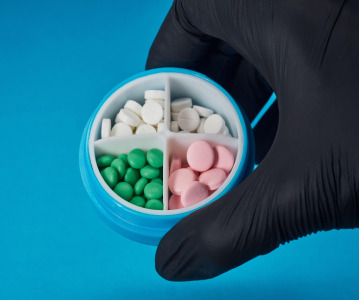CPHI Webinar Series – The Big Questions: Pharmaceutical Packaging, Sustainability and Circularity
.png)
With growing awareness for sustainable industry practices within pharmaceuticals, pharma packaging companies are facing pressures to balance drug efficacy, patient safety, supply chain security, and sustainability. Speakers Sriman Banerjee, Head of Packaging Development & CDE, R&D Pharma Sci at Takeda, and Félice Pachot, Health Market Manager at Adelphe, presented on how the creation of circular economy within the pharmaceutical packaging chain would work, from value chains to product design and development. Here we cover the biggest questions asked during the CPHI Online webinar series episode ‘Creating a Circular economy for the Pharmaceutical Packaging Industry’.
Creating a Circular Economy for Pharma: Key Takeaways
Banerjee began the webinar with a presentation covering a brief history of pharmaceutical packaging, and the ever-growing shift toward sustainable packaging. He introduced a circular economy as a fundamental principle interconnecting every part of the packaging lifecycle – cradle-to-cradle packaging would recover packaging materials at the end of its lifecycle and return it into the manufacturing cycle to repurpose. Through several case studies looking at the design and implementation of sustainable pharma packaging within a circular economy, Banerjee provided an assessment of a lifecycle methodology, an example of which included the ECODEX with four focus areas in carbon, water, waste, and substances of high concern. The pharmaceutical packaging industry, it turns out, has many avenues to go down when operating in a circular economy: use of recycled materials in secondary and tertiary packaging, standardization and reduction of use in materials, and digitising leaflets were all examples of activities pharma packaging companies could adopt that Banerjee cited. He also covered concerns with evolving requirements and regulations in regard to annual reporting of packaging material used, packaging use tax, and single-use plastic bans across the globe. With legislations constantly changing and sustainability trends shifting focus across several issues, the scope and activity of the pharmaceutical packaging sector within a circular economy, Banerjee emphasizes the number of innovations and opportunities for packaging companies to keep up with regulations.
The next speaker, Pachot, focussed on cross-industry partnerships as an essential component of creating a circular economy for the pharmaceutical packaging industry. The question surrounding her portion of the webinar asked how prevention and eco-design plans could engage pharmaceutical companies in a circular economy. Through several case studies, Pachot also presented on waste packaging management and regulatory obligations in France and to an extent the globe. Echoing Banerjee, she presents a circular economy as an economic concept part of sustainable development. A key principle Pachot presented was Extended Producer Responsibility (EPR), in which manufacturers and marketers are responsible for their products and their packaging’s end-of-life impact, encouraging eco-design practices. With many countries implementing EPR practices in 2020 and a more demanding regulatory context for sustainable packaging, such as Article 72 of the anti-waste and circular economy law in France, an eco-design plan would feed packaging strategies and formalise actions to be carried out. Pachot highlighted two ways to comply with such laws – individual plans and mutual plans. Mutual plans, Pachot stated, could drive inspiration for the whole pharmaceutical sector, not just packaging, in order to aggregate and analyse data from all plans. Prevention and eco-design plans are a real opportunity to reduce every company’s environmental impact and reduce the footprint of the whole pharmaceutical sector.
What Are the Big Questions Around Pharma Sustainability?
Amber alert: balancing drug efficacy and sustainability
Some of the most asked questions during the Q&A portion of the webinar concerned drug safety and efficacy when thinking about sustainable packaging, and where in what state it might leave certain types of packaging in the future. An example was that of colourless glass vials versus amber vials. With amber vials developed to offer light protection, Banerjee sheds light on how to balance certain protection barriers with sustainable practices – in the short term, Banerjee does not see any changes on regulations regarding amber vials. However, he highlights some innovations in development for UV protection in colourless vials, as well as developments in secondary and tertiary packaging that would still contribute to a sustainable, circular economy for packaging.
Obligatory eco-design plans around the world?
Worldwide sustainability practices and implementing global circular economies were a hot-topic question. Pachot was asked whether obligatory eco-design plans would come into effect in Europe and the United States. While she stated she did not foresee such obligations occurring anytime soon, she emphasized that activities within the French pharmaceutical packaging market could set a precedence for global efforts towards a circular economy.
The economics of investing in a circular economy
Some viewers questioned whether it would be best to invest in R&D for sustainable yet cost-effective materials to contribute to a circular economy. Banerjee highlighted various R&D projects for the development of affordable and sustainable materials, including flexible packaging alternatives to aluminium. However, he emphasized the thin line of balance between achieving sustainable practices, a circular economy, cost-effectiveness, and affordable materials. The most we could expect from such investments in R&D would be long-term results to achieve this balance, Banerjee stated.
Prioritizing a circular economy and reducing packaging footprints
Questions regarding this balance between cost, safety, and sustainability led to many questioning how much of a priority such eco-practices should be in a company’s purview, and how far ahead should the industry look. Pachot was firm in her conviction that, with recent regulations and legislations, sustainability and a circular economy should be a top concern for the pharmaceutical packaging industry, and companies should look well ahead in order to not only remain relevant to customers and clients but also to become industry leaders in sustainable practices for safe and effective drug packaging.
View the webinar video on-demand here. For more content on sustainability in pharma, visit our Sustainability Hub.
Related News
-
News Pharmapack Awards 2024 Patient-Centric Design Award Winner – Dr Ferrer BioPharma
The 2024 Pharmapack Awards celebrated the best in innovation and design for the pharmaceutical packaging and drug delivery industry on January 24, 2024. -
News Pharmapack Awards 2024 - Celebrating Packaging and Drug Delivery Innovation
The 2024 Pharmapack Innovation Awards ceremony celebrated the best in pharmaceutical packaging and drug delivery innovation at all levels. The awards were held on January 24, 2024 at the Paris Expo Porte de Versailles. -
News Women in Pharma: Looking back on 2023 and moving forward to 2024
In this monthly series, we interview women from across the pharmaceutical industry and supply chain to discuss the importance of gender diversity in healthcare, the workplace, and beyond. -
News On track at CPHI Barcelona - The Track Sponsor interview: USP
In our packed out content sessions at CPHI Barcelona this year we focus on some of the hottest topics coming up in the pharma industry, with each track sponsored by a leading expert in the field. -
News Women in Pharma: Marketing for the other half in healthcare
In our new monthly series, we interview women from across the pharmaceutical industry and supply chain to discuss the importance of gender diversity in healthcare, the workplace, and beyond. This instalment highlights not only the importance of ma... -
News Bringing the pharmaceutical supply chain closer to home
The pharmaceutical supply chain has encountered numerous disruptions in the last few years, impacting procurement, manufacturing, packaging, and distribution operations within the pharmaceutical industry. Read about the rise in calls for near/resh... -
News Delivering on mRNA-based therapeutics: innovations in applications and packaging
Since the onset of the COVID-19 pandemic, the innovative potential of mRNA vaccines and therapeutics has raised questions regarding their manufacturing, packaging, and storage/transportation. Learn about how the pharmaceutical supply chain is meet... -
News Your Prescription for Marketing Success: Digital Pharma Marketing Toolkit – Free eBook
Download your FREE pharma marketing eBook to learn why it is so important for pharmaceutical marketeers to develop their digital content marketing strategies in order to establish their companies as thought leaders and industry experts.
Position your company at the heart of the global Pharma industry with a CPHI Online membership
-
Your products and solutions visible to thousands of visitors within the largest Pharma marketplace
-
Generate high-quality, engaged leads for your business, all year round
-
Promote your business as the industry’s thought-leader by hosting your reports, brochures and videos within your profile
-
Your company’s profile boosted at all participating CPHI events
-
An easy-to-use platform with a detailed dashboard showing your leads and performance







